Valentino Rossi – how the biggest name in MotoGP battles a grid half his age

Only 22 days after breaking his right tibia and fibula in an enduro biking crash while training, Valentino Rossi has been given the all clear by the MotoGP medical staff to make a comeback at Aragón this weekend after having had to sit out the last round at Misano.
At 38 years of age what is remarkable is the degree of angst and annoyance that the Movistar Yamaha rider will likely harbour in having missed his true home Grand Prix of the season, and also another chance of that elusive tenth world championship.
It was Mark Twain who said: “Age is an issue of mind over matter. If you don’t mind, it doesn’t matter.” Rossi, a global motorcycle racing icon and recently a veteran of 300 MotoGP outings (89 of which he has won and emerged from 190 with a trophy) is clearly mindless of the knife-edge and searing level of competition – inches, hundredths of a second and blinks of an eye – on which he lives.
Ironically he sustained the broken leg away from the mind-boggling speed of MotoGP; a fall while on an enduro bike causing the double right leg fracture and a very rare spell on the sidelines.
Rossi is still so competitive, so popular and so quick, apparently thanks in part to the regular "extra curricular" riding he has cited this reason for his thriving resilience in MotoGP. At the race before last, the British GP, he fenced with rivals Maverick Viñales (22), Marc Marquez (24), Andrea Dovizioso (31) and Cal Crutchlow (31) in a riveting and close race at Silverstone. The Italian led 17 of 20 laps at the long and bumpy asphalt in surprisingly hot conditions before succumbing to the late threat of ‘Dovi’ and his younger team-mate Viñales.

Rossi is the most obvious beacon for MotoGP and not only for his results, achievements and colourful demeanour but also through cultivating a VR46 brand, for bringing an outgoing and fun personality to a motorsport that still satisfies the definition ‘extreme’ and, above all, for his baffling endurance and tenacity.
He could easily be sitting in a bar in Tavullia (maybe his own pizza restaurant) on the Adriatic shore and dirt-tracking for fun on his private ranch facility, but instead he continues to search for excruciating marginal gains while also nursing aches and pains from the physicality of throwing a motorcycle around at 350kph.
At this level bike racing strains muscle groups and the senses. It tires the brain, reaction speeds and perception. Then there are extra pressures of troubleshooting set-up issues, dealing with fans, sponsors, media and TV, and trying to keep a hand in the dispute for a tenth crown. Rossi also owns a licencing empire that handles everything from his own VR46 brand to half of the MotoGP grid to Juventus Football Club. He co-runs two race teams in Moto3 and Moto2 categories and oversees an ‘academy’ of young hopefuls. He has his own energy drink and video game.
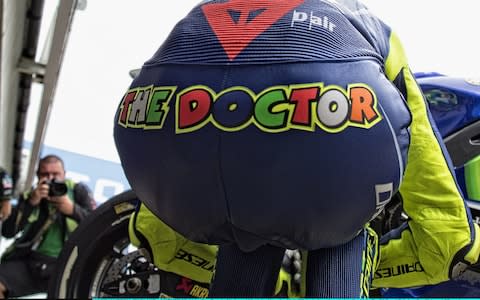
One of the VR46 Academy members, Franco Morbidelli, who heads the Moto2 championship with seven wins and was another podium finisher at Silverstone, shed some light on regular existence for his mentor. “Vale is not able to live a normal life. He cannot walk by the seaside. If I do it then just a couple of people stop and ask me for a photo or an autograph. I’m lucky and I can enjoy it.”
It is on the track and the kind of performance and speed that keeps Rossi at the front of a pack that were 15 seconds faster last weekend compared to Silverstone 2016 that really dazzles. It is also something that slightly boggles his peers, particularly around the Northampton layout that was bumpier and more punishing for the ’17 edition of the British round of MotoGP after the abuse from F1 and car track days.

“There are a lot of fast changes of direction so the bike is really heavy with the inertia and the G-force you are trying to pull across the track,” described Crutchlow who was perturbed by a lack of front end grip in his quest for a second consecutive podium and classified fourth. “Honestly, it is a difficult. Not in terms of the cardio with breathing but upper body; the bigger guys have an advantage with the leverage they have.”
“Rossi’s advantage is that he is very tall and his arms and fingers are long and this helps him, even if he is not the fittest rider,” claims former teammate Jorge Lorenzo, who steered his Ducati to fifth spot. The Majorcan is still adapting to the fierce Desmosedici in his first term on the distinctive red machinery.
“His body length helps him move the bike and he doesn't get so tired. If you are small or have shorter arms then you suffer more riding the bike. This is his luck. Also riding the Yamaha, which is a soft and friendly bike, helps him but obviously he has a lot of merit to keep at it for so long, especially his motivation.”

“This track really tires the arms because you are leant over a lot,” offered Viñales, who was born just over a year before Rossi made his Grand Prix debut in 1996. “Physically he is strong and can easily get through.”
MotoGP rookie Johann Zarco, one of the best stories of a fraught and unpredictable 2017 campaign thanks to his breakthrough speed and results as part of the Monster Yamaha Tech3 satellite set-up (essentially using Rossi’s hardware from 2016), believes the Italian’s excellence and ability to withstand is down to his acumen on the M1. “I think Rossi is able to be fast and stay relaxed on the bike, even if a track like Silverstone is difficult because we are going so fast into the corners and you must hold the bike [hard] to not have too much movement; with this lap after lap you will get tired.”
“He is the one that can really fix the bike perfectly so that he doesn't compensate with the body,” the Frenchman reveals. “I am working to find this good set-up, like he does, but I need time to understand it.”
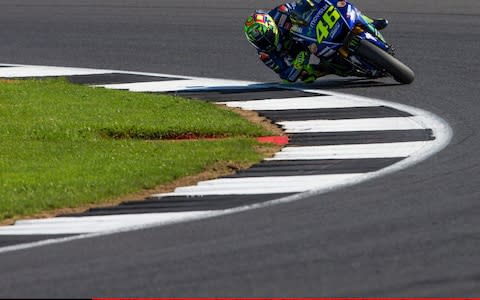
As is the case for Misano this weekend, set-up was key at Silverstone, mainly due to the rippling asphalt that many claimed was in a worse state despite resurfacing in several corners. “MotoGP bikes are very stiff, the tyres are very stiff, and through the bumps it's very difficult to stay on the limit and at the same time try to be smooth,” described eventual winner and new championship leader Dovizioso. “You use a lot of energy to try to combine this. So it's very demanding. With every acceleration you have a lot of movement from the rear tyre so you have to pull the handlebars to try to stabilize the bike. It's very difficult.”
“The level and these tyres and bikes are getting up to now [mean] it’s like a qualifying lap for every single lap of the race,” offered Red Bull KTM’s Bradley Smith, one of the most articulate scholars of the art of MotoGP and a rider still trying to find some magic elixir with the new RC16. “The level that we need to ride to get a good result now means you have to be on form, you have to feel good and move forward.”
The 26 year old cites the volume of extra saddle hours his fellow athletes undertake as one reason for the longevity. In Rossi’s case the Italian has admitted that the dirt track and off-road riding at The Ranch – risks considered – have preserved his love for two-wheels and speed and helped hone his technique for the narrow capabilities of control tyres and the development of sophisticated electronics that have pushed riders to approach MotoGP in a particular way. Being surrounded by the Academy youngsters has locked his competitive juice into a slow-feeing drip.
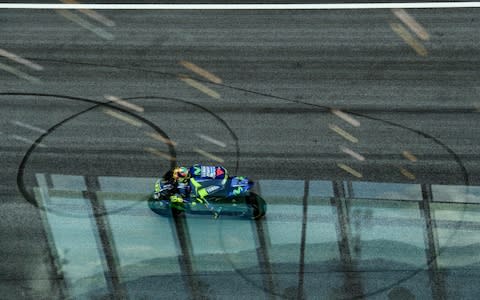
“More and more people are doing extra training and more people are riding other bikes in terms of dirt track, motocross, supermoto,” says Smith. “This is all being implemented. Even Jorge [Lorenzo] was out on a 958 in Como somewhere. Bike time is bike time and this is a key part of this sport. If you look in terms of the overall race times in the last five years they keep going down and the gap between first and last laps are getting closer.”
Rossi has a strong association with Yamaha that should see him celebrate his 40th in MotoGP. He has spent twelve of his eighteen years in the premier class and building up to that 300 with the Iwata firm. Realistically it is unlikely many of his rivals will stretch as far.
“Could I imagine doing it at 38? At the moment yeah, but year by year I get more pain in my body although my motivation doesn't get any less and I don't get any slower,” speculates Crutchlow who will be in Grand Prix until the end of 2019 with Honda. “Over the years I don't think Valentino has gotten any slower but the competition has got faster and he’s still there. He’s a completely different body type to me but I think he rides a lot easier than what I do. To be honest I could not imagine being here at 38!”
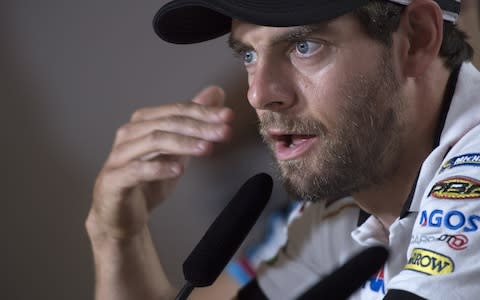
“It is difficult to imagine how my body would react for so many years but physically I am very well [sic], better than ever, and every year I try to make another step,” said Lorenzo, a five times champion and who turned 30 in May. “I changed my trainer and I like the way we work together but it is true that the Ducati is very demanding compared to my old bike and makes the second half of the race more physical. Little by little we are making the bike less physical and less tough.”
Rossi regularly puts a smile into his racing and that of MotoGP generally. He is the chief power-player in the paddock but also continues to be the reference once out of the pitlane and on the throttle. His age might blunt the physicality and rapier intensity needed for a balls-out qualification lap – he has just six Pole Positions this decade – but he is a racing animal. One that still prowls through the long grass, still the hunter.
“Unfortunately every year is a bit more difficult,” he grins. “To try to train more, to be more ready and in the end try to arrive with the same result. Riding in MotoGP is demanding but it is also important to have other things [in life]. It also depends a lot on the race [itself]. It depends on the setting of the bike and if you feel good, if you are fighting for a good result: everything is easier. The opposite also; if you have more problems then it is difficult physically also.”
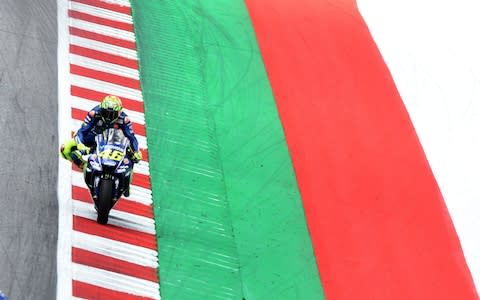
“[Silverstone] was a great way to make my 300th race in MotoGP: staying at the front and fighting for the victory,” he adds. “This was my target and while I have the speed to fight with the top guys then I will continue. I was able to ride well and give the maximum; I enjoyed the race.”
Rossi’s impish glee at putting on a show and meeting his goals is another of his timeless traits. The costumes and gimmicks of his youth have faded but the exertion and enthusiasm has stayed fixed. The 2017 campaign has turned and then flicked back in another direction – just like the kinks of Silverstone and Misano – and Rossi’s exclusion from a four-rider title chase is one of the saddest narratives so far. There was already talk of when he’ll be back on the M1 just a day after he’d had a titanium pin inserted into his right leg for the second time, and another process begins again.
Rossi clearly does attribute much to his age but the cornerstones of his existence – riding and racing motorcycles – obviously matter a great deal: are there fewer activities better at staving off the march of time?

 Yahoo Sport
Yahoo Sport 





































